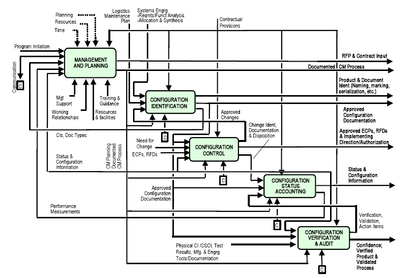
Back إدارة التهيئة Arabic Konfigurationsmanagement German Gestión de la configuración Spanish مدیریت پیکربندی Persian Gestion de configuration French ניהול תצורה HE Gestione della configurazione Italian 構成管理 Japanese Конфигурация диспетчері Kazakh 구성 관리 Korean
This article may need to be rewritten to comply with Wikipedia's quality standards. (November 2023) |
| Business administration |
|---|
| Management of a business |

Configuration management (CM) is a management process for establishing and maintaining consistency of a product's performance, functional, and physical attributes with its requirements, design, and operational information throughout its life.[1][2] The CM process is widely used by military engineering organizations to manage changes throughout the system lifecycle of complex systems, such as weapon systems, military vehicles, and information systems. Outside the military, the CM process is also used with IT service management as defined by ITIL, and with other domain models in the civil engineering and other industrial engineering segments such as roads, bridges, canals, dams, and buildings.[3][4][5]
- ^ "MIL-HDBK-61A, ""Military Handbook: Configuration Management Guidance". Department of Defense. 7 February 2001. Archived from the original on 20 March 2012. Retrieved 24 March 2012.
- ^ "ANSI/EIA-649B, ""National Consensus Standard for Configuration Management". TechAmerica. 1 April 2011. Archived from the original on 1 August 2012. Retrieved 24 March 2012.
- ^ "History and Heritage of Civil Engineering". ASCE. Archived from the original on 16 February 2007. Retrieved 8 August 2007.
- ^ "Institution of Civil Engineers What is Civil Engineering" (PDF). ICE. Archived from the original (PDF) on 23 September 2006. Retrieved 22 September 2007.
- ^ "Configuration Management and the Federal Transportation Administration (FTA) National Lessons Learned Program". Federal Transportation Administration. Archived from the original on 7 September 2012. Retrieved 22 September 2007.